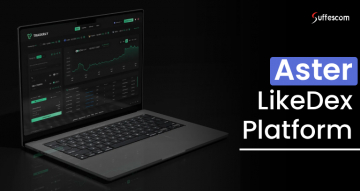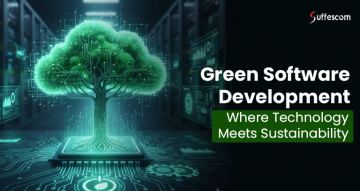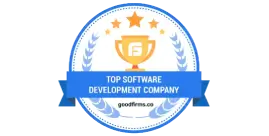Food Waste Management Business App Development: Tech Stack, Key Steps & Cost

Food waste is not just an ordinary concern; it's a critical global issue. Did you know that nearly one-third of all food made for human consumption is wasted? This crisis demands our immediate attention and solution, though.
Food waste leads to monetary losses: Only in the US reign did about 39% of food turn into waste, valued at around $408 billion, roughly 2% of the national GDP. This data emphasizes an expanding food waste management industry in the coming future. The irony is that both hunger and food waste are rapidly increasing. This means that we are not lacking in food; we are lacking in the medium to transfer food to hungry folks.
Technology has proven to be one of the best ideas for solving food waste. Just as mobile apps have connected companies to job seekers, a food waste management app could be the key to reducing food waste and ensuring that excess food is distributed to needy ones. This technological solution offers hope in the fight against food waste.
Food Waste Management App Development
Suffescom Solutions specializes in developing innovative Food Waste Management Apps, offering customized solutions with real-time tracking, AI integration, and seamless user experience, aimed at reducing food waste and promoting sustainability.
How Can Mobile Apps Help Reduce Food Waste?
Numerous mobile apps in the market aim to reduce food waste and distribute food to needy people. However, all apps are different as they do not work in the same flow. Every app has its working algorithms to ensure the sustainable management of food. These management principles help ensure that each needy will get benefits and excess food from distribution communities and social groups.
Unsold Food At Lower Rates
There can be many reasons why food remains unsold in a store or outlet. It doesn't mean that the food is not edible anymore. However, it is also impossible for store owners to give away that food for nothing. Thus, some food waste apps help sell these items to needy people at very low prices or for free as a charity. These food items are usually available at discounted prices of 40% - 50%.
A Bridge Between NGOs And Food Outlets
One popular way to use food waste management apps is to connect food outlets to NGOs that distribute food to needy people. The application facilitates this connection by allowing food outlets to list their surplus food, which is then picked up by a volunteer and delivered to those in need. These NGOs play a crucial role, inspiring us with their dedication. This process ensures that excess food is not wasted and reaches those who need it most.
Neighborhood Food Sharing
Restaurants and hotels are not the only ones responsible for food waste; residents also contribute to this issue. These apps allow users to list leftover or excess food that can be consumed. People nearby can access the app to contact the first person to bring the food. The neighborhood-sharing concept of food is an excellent way to sustain food and promote a better future with less food waste.
Food Donation
These apps even allow the direct donation of food to people in need. For instance, restaurants and eateries can donate excess cooked meals, fresh produce, or packaged goods to charities and community groups. The flexibility and effectiveness of these apps, with their regularity and random listing, make them an encouraging and effective way to reduce food waste.
Expiration Reminder
According to the reports, almost 20% of food waste is caused by confusion in food labeling. Many people throw the food away just to be safe as they don't know the difference between the expiry date, sell-by date, use-by date, best-before date, etc. So, mobile apps like Too Good To Go have come up with the right solution. Households and merchants can use an app to scan barcodes on packaged food. The app will send a reminder when the food is about to expire, preventing it from being thrown away prematurely. This allows the owner to take steps for sustainable food management as the expiration date approaches.
Features Included While Developing Food Waste Management App
Whether you are an entrepreneur planning to build a food waste management app for multiple vendors or a government organization, the app is uniquely designed to accommodate your needs. With these key features, we ensure that the app is adaptable to different users, thereby increasing your success probability rate. Here are the key features that set our waste management app apart:
Food Stock Forecast and Suggestions
This section, integrated with data analytics, efficiently analyzes inventory and waste. It compares the added inventory with market fluctuations to study food demand for the specified period, providing you with accurate and reliable forecasts and suggestions.
Instant Messaging
As we discussed earlier, the app provides various communication bridges. The instant messaging feature, in particular, offers a convenient and efficient way for restaurants to connect with food recycling companies or NGOs and schedule waste pickup, making the process smooth and hassle-free.
Real-time Location
Integration of maps is a critical component of a food waste management application. Delivery partners working on picks and deliveries can see the locations in real-time, ensuring efficient and hassle-free operations. Entities involved in the process can also track progress efficiently and effectively, providing a sense of control and reassurance.
Video Playback
A food waste management app should feature video playback. These videos, serving as educational tutorials, will inform and empower parties involved in the food trade about reducing food waste. Chefs can analyze and modify the recipes to reduce waste, feeling more informed and in control.
Vision AI
Artificial intelligence can enhance your application's work capability. Features like vision AI can use smartphone camera hardware to capture pictures of food items. These pictures will then undergo intelligent screening to identify possible waste and suggest ways to reduce waste.
Tracking Dashboard For Top Management
A tracking dashboard for top-level management or super admins is included. Authorities can get consolidated reports on how much food was wasted and how much is sustained. Using this feature, they can make informed decisions for the betterment of the future.
Expiration Reminder for Inventory
The expiration reminder feature, a universal cure for wholesalers, plays a crucial role in enhancing customer health and safety. By sending push notifications when items are nearing their expiration date, it helps prevent waste and significantly improves the user experience. It will strengthen your commitment to customer health and safety, demonstrating your responsibility and care.
Types of Food Waste Management Apps Development
Food waste management apps work identically, but goals operate differently. Since, each app addresses different aspects of the food waste problem. Here are some common variations of Food waste and surplus food selling app:
1. Food Outlet & Restaurant Apps for Cost Savings and Charitable Impact
In today’s competitive food service industry, managing costs with quality service is a challenge. Food outlets, restaurants, and grocery stores can slightly reduce their costs by offering leftover food items at discounted prices at day end. Moreover, charity facilities provide a platform for vendors to make wholesale orders and donate them to the needy ones, further enhancing the sense of efficiency.
Benefits of Discounted Leftover Food -
- A fully-functional app minimizes losses from unsold goods by selling leftover food at discounted prices.
- Transform potential waste into revenue to offset daily operational costs.
- Provide customers with a convenient and affordable way of purchasing food, improving overall satisfaction.
- Differentiate your business from competitors by offering unique, socially engaging solutions.
- Simplify inventory management and facilitate sales processes through the app’s user-friendly interfaces.
| Integrations | Purpose |
| Streamlining Transactions | Simplify the process of listing discounted leftover food and facilitating transactions |
| Data Analytics | It help businesses track sales patterns, understand customer preferences, and manage inventory more efficiently |
| Partnership Platforms | Designed to connect food vendors with charities, creating a seamless platform for making donations |
2. Meal Tracking Apps
Meal sharing apps are platforms designed to connect individuals within a community who are interested in sharing or exchanging food. These apps enable users to offer surplus meals, ingredients, or groceries to others nearby. The goal is to reduce food waste, promote community engagement, and provide diverse dining experiences.
Benefits of Meal-Sharing Apps -
- By sharing surplus food, users create a helping environment. This benefits the environment and conserves resources.
- Meal sharing apps foster relationships among residents, encouraging a sense of community and cooperation.
- Users can explore a variety of home-cooked meals with unique ingredients, expanding their culinary horizons and trying new flavors.
- By exchanging or receiving surplus food, individuals can reduce their grocery expenses and make the most of what they have.
- Sharing food helps reduce the environmental impact of food production and distribution by minimizing waste and preserving resources.
Transform Food Waste into Business Opportunity
Partner with Suffescom Solutions to develop a cutting-edge food waste management app that turns surplus into sustainability. Let's innovate together for a greener tomorrow.
| Integrations | Purpose |
| Local Food Networks | The app collaborates with local food bankers, community kitchens, and nonprofit organizations, leveraging their resources to coordinate significant food redistribution efforts and support those in need. |
| Location-Based Services | By incorporating GPS and mapping technologies, the app users quickly locate and connect with others nearby, facilitating picking up or delivering food. |
| Notification Systems | Notifications to alert users about new food listings, pickup arrangements, or updates, ensuring timely and efficient communication. |
| Sustainability Metrics | The app will track and display metrics related to food waste reduction and environmental impact, helping users see the real benefits of their participation. |
| Overall Purpose | The app is designed to provide a more sustainable and connected community by promoting the sharing of surplus food. It helps users reduce waste, discover new foods, and, most importantly, instill a sense of responsibility as a human. |
How to Develop a Food Waste Management App?
Define the Purpose and Features
Start by clearly defining the purpose of your food delivery app. Identify the most critical features, such as restaurant selection, real-time tracking, and user reviews.
User Interface and Experience Design
Design a universal feature that displays different restaurants and explores various types of menus to choose their meals. Connect with restaurant management software to ensure that your menus are updated and reflect the current stock of your dishes.
Backend Development
Focus on backend development by establishing a solid server infrastructure, managing databases, and integrating necessary APIs. Choose a scalable and secure framework for your backend operations, such as Django or Express.js.
Database Design
Design a robust database schema to manage user profiles, restaurant data, menu items, and order histories. Utilize efficient database management systems like PostgreSQL or MongoDB to ensure quick data access and processing.
User Registration and Authentication
Implement a secure and user-friendly registration and authentication system. Make the registration process simple and quick, encouraging more users to sign up.
Restaurant Selection and Menu Integration
Develop a comprehensive feature allowing users to browse various restaurants, view detailed menus, and select their desired dishes. Integrate with restaurant management systems to keep menus up-to-date and provide real-time availability of dishes. Users can filter and sort restaurants based on cuisine, ratings, distance, and other preferences.
Order Placement and Payment Processing
Recipes can be easily customized and arranged according to type, ratings, distance, and other options users choose. The orders' placing procedure is meticulously designed for maximum convenience, with presetting abilities and special instructions provided. The app interacts with reliable payment systems, ensuring a seamless and secure transaction process.
Real-Time Tracking and Notifications
The goal is to deliver push notifications to bring user attention to necessary steps, like order confirmation, dispatch, or delivery. We empower users to voice their opinions on restaurants and delivery experiences through reviews and ratings. This active participation not only helps users make informed decisions but also contributes to the app's evolution. We ensure that all user-generated content is constructive and enriching, fostering a positive community environment.
Customer Reviews and Ratings
Enable users to provide feedback on restaurants and delivery experiences through reviews and ratings. This feature is not just a tool for making informed choices, but also a platform for users to share their experiences and shape the app's future. Implement a moderation system to ensure that reviews are constructive and adhere to community guidelines, fostering a sense of community and shared responsibility.
Community Engagement
Encourage user engagement by incorporating features like loyalty programs, referral bonuses, and social media sharing. Users can earn rewards for frequent orders, referring friends, or sharing their experiences on social platforms.
Testing and Quality Assurance
Thoroughly test your food delivery app to guarantee that it responds well to all devices and operating systems. This includes conducting usability tests to ensure the app is easy to use, security reviews to protect user data, and performance baselines to diagnose potential issues. These measures ensure the app's reliability and user satisfaction. Our commitment to regular testing and quality assurance is a testament to our dedication to consistently offering a high-quality service and ensuring user satisfaction. This commitment guarantees you a reliable and high-quality app that you can trust for your food delivery needs.
Tech Stack Used in Food Waste Management App Development
To develop a fully functional food waste management app, we need to consider the following tech stack:
| Programming Languages | Java, Kotlin (Android), Swift, Objective C (iOS), Flutter (cross-platform) |
| Database | MongoDB, MySQL, PostgreSQL |
| Front-end Frameworks | React.js, Vue.js, or Angular |
| Cloud Integration | AWS, Microsoft Azure, Google Cloud Platform |
| Geo-location | Google Maps API |
| Payment Gateway APIs | Stripe, PayPal, Braintree |
| Waste Classification API | Clarifai API, Google Cloud Vision API |
Revenue Generating Reasons to Develop Food Waste Management App
Developing a food waste management app can offer several revenue-generating opportunities while significantly impacting the environment and addressing a pressing economic issue. Here are some compelling reasons and revenue streams to consider:
Subscription Model
Consumer Subscriptions: By offering premium features such as detailed analytics, personalized offers, or advanced tracking for a monthly or annual fee, we provide users with a complete tool for managing food waste while creating a stable revenue stream.
Business Subscriptions: Businesses can provide tailored solutions for restaurants, grocery stores, and other food businesses. These solutions offer features for inventory management, waste tracking, and reporting, all created to streamline operations and reduce waste.
Advertising and Sponsorships
Local Advertisements: Partner with local businesses or food brands to advertise their products or services within the app.
Sponsored Content: Feature sponsored articles or tips for food conservation, cooking, or sustainable practices.
Charitable Partnerships
Donation Options: Users can donate their saved resources or points to food banks or other charitable organizations, with a percentage of donations going to the app’s development and maintenance.
Design Food Waste Management App: Reduce, Reuse, and Innovate
Work with Suffescom Solutions to design a Food Waste Management App that encourages sustainability through innovative waste reduction strategies. Together, we can make a lasting environmental impact.
Cost of Food Waste Management App Development
An essential app can cost around $10,000, and a medium to advanced app costs around $15,000 to $30,000.
Some reasonable aspects are apparent, such as:
- Infrastructure costs (Domain, hosting, data servers)
- Here are some of the factors mentioned below:
- Hosting
- Security & Compliance
- New Features Integration
- Customer Support
- Third-party Tools Integration
- Bug Fixing & Updates
- Analytics
- UI/UX updates
- App Maintenance
- Marketing
- Patent
- And others
However, the total cost of creating such innovative food waste solutions. The more complex your expectations are, the more talented developers and tech stack you need! However, you still need to get your price estimation before working on such a custom food waste management application. We at Suffescom have decades of market experience in the food industry, where we have worked on the latest trends like AI and ML.
To Reduce Food Waste Create Management App and Software
With a decade of experience developing mobile apps and create any industry oriented mobile application that suit to your business needs, such as Food Waste Management Apps, Food delivery app, Subscription based food, Cloud kitchen app and restaurant table reservation app. Our unique focus on providing value to our clients sets us apart from other companies. We have a dedicated mobile app, AI/ML, react JS, and Flutter technologies team. With 500+ developers, we are confident in our ability to make small start-ups stand out in the competitive market, giving you the reassurance you need to succeed.







